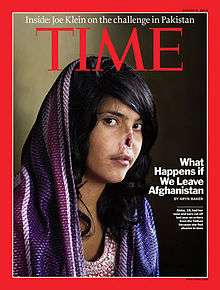Bibi Aisha
Bibi Aisha (Pashto: بي بي عایشه; Bibi is a term of respect meaning "Lady"; born Aisha Mohammadzai,[1] legal name in the United States: Aesha Mohammadzai) is an Afghan woman whose mutilated face appeared on the cover of Time magazine in summer 2010.


Her story first appeared in The Daily Beast in December 2009, which prompted doctors to write in, offering to help her for free. The Grossman Burn Foundation in California pledged to perform reconstructive surgery and began organizing for her visa in the early spring of 2010. Diane Sawyer of ABC News originally covered her ordeal in March 2010 and revisited her story again in 2014.
Life in Afghanistan
Aisha suffered early in life, losing her mother and forced into marriage as a teenager.[1] In a practice known as baad, Aisha's father promised her to a Taliban fighter when she was 12 years old as compensation for a killing that a member of her family had committed. She was married at 14 and subjected to abuse. At 18 she fled the abuse but was caught by police, jailed for five months, and returned to her family.[2] Her father returned her to her in-laws. To take revenge on her escape, her father-in-law, husband, and three other family members took Aisha into the mountains, cut off her nose and her ears, and left her to die.[3] Aisha was later rescued by aid workers and the U.S. military. Some sources disputed the role of any members of the Taliban in her mutilation.[4][5]
Appearance in Time magazine
Aisha was featured on the August 2010 cover of Time magazine, and in the corresponding article, "Afghan Women and the Return of the Taliban."[6] The cover image generated enormous controversy.[7] The image and the accompanying cover title, "What Happens if We Leave Afghanistan," fueled debate about the merits of the Afghan War.[8]
The photo was taken by the South African photographer Jodi Bieber and was awarded the World Press Photo Award for 2010.[9] The image of Aisha is sometimes compared to the Afghan Girl photograph of Sharbat Gula taken by Steve McCurry.[10]
Life in the United States
Shortly after Time's cover ran in August 2010, Aisha was flown to the United States to receive free reconstructive surgery.[7] After arriving in California, she psychologically regressed into performing fake seizures, tantrums, and self-harm that required hospitalization. Surgeons concluded that she was not "emotionally prepared" to handle the patient responsibilities in the reconstructive surgery process, and her psychologist diagnosed her with borderline personality disorder.[11] While her reconstructive surgery was delayed, she was taken in by the Women for Afghan Women shelter in Queens, New York, but she caused many problems for the staff and other residents, including roommates hired by the shelter to live with her.[11] Aisha's condition improved with a change in medications, and the seizures stopped.[11]
Later, Aisha's psychological condition improved enough that she was able to cease taking medications to control her behavior. Starting in 2012, preparations to do a multistage facial reconstruction for Aisha began.[11] Her forehead was expanded over the course of several months to provide enough tissue to build a new nose. The structure for her new nose was built using cartilage from her own body and tissue from her left hand was also used for the inner lining.[11] Aisha underwent a total of 12 completed surgeries.[12]
In 2014 ABC News revisited Aisha and revealed her new nose that has altered her appearance. Aisha has been adopted by an Afghan-American couple, and lives in Maryland.[13] She studies English and mathematics and aspires to be a police officer.[11]
See also
- Sahar Gul, Afghan teenager abused by in-laws
References
- 1 2 "For Aesha, healing comes in many forms". CNN. 20 December 2012. Retrieved 11 February 2015.
- ↑ Grenoble, Ryan (27 February 2013). "Afghan Woman Who Had Nose, Ears Cut Off By Taliban Recovers". Huffington Post. Retrieved 11 February 2015.
- ↑ Bates, Karen Grigsby (13 October 2010). "Bibi Aisha, Disfigured Afghan Woman Featured On 'Time' Cover, Visits U.S.". National Public Radio blog: The Two-Way. Archived from the original on 12 November 2010. Retrieved 27 November 2010.
- ↑ Ann Jones, 'Afghan Women Have Already Been Abandoned', The Nation (12 August 2010).
- ↑ Ahmad Omed Khpalwak, 'Taliban Not Responsible for Cutting Aisha's Nose, Ear', Uruknet (6 December 2010).
- ↑ Baker, Aryn (29 July 2010). "Afghan Women and the Return of the Taliban". Time (magazine). Archived from the original on 2010-08-16. Retrieved 27 November 2010.
- 1 2 "Disfigured Afghan on Cover of Time Heads to US". AOL News. 5 August 2010. Archived from the original on 22 October 2010. Retrieved 27 November 2010.
- ↑ Nordland, Ron (4 August 2010). "Portrait of Pain Ignites Debate Over Afghan War". The New York Times. Retrieved 27 November 2010.
- ↑ Webb, Sara (11 February 2011). "Top press award for photo of disfigured Afghan woman". Reuters. Retrieved 11 February 2011.
- ↑ Rubin, Elizabeth (December 2010). "Veiled Rebellion". National Geographic Magazine. Archived from the original on 6 December 2010. Retrieved 27 November 2010.
- 1 2 3 4 5 6 "Saving Aesha". CNN.
- ↑ Video chronicling her surgery by the American Society of Plastic Surgeons (Nov 2014)
- ↑ "Meet Aesha, a Symbol of Strength and Triumph" ABC News video (July 2014)
External links
- Aisha takes the subway 2011 Aisha in 2011
- Saving Aesha
- Afghan Women and the Return of the Taliban, the cover story in Time magazine
- Brutalized Afghan Woman Finds Strength Diane Sawyer ABC News Special on Bibi Aisha
- An Unspeakable Crime, Original Daily Beast Story by Gayle Tzemach Lemmon
- Grossman Burn Foundation Bibi Aisha page